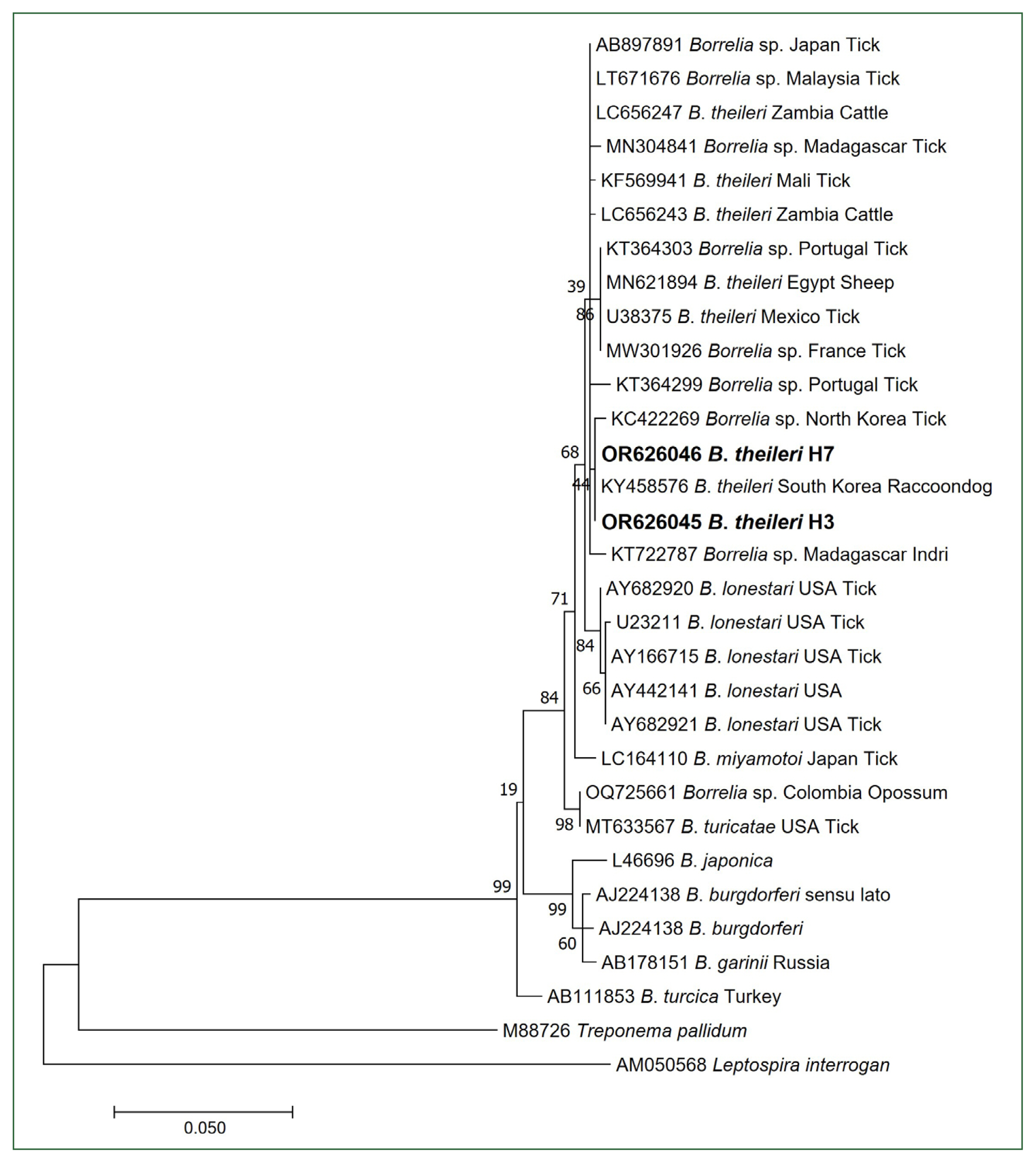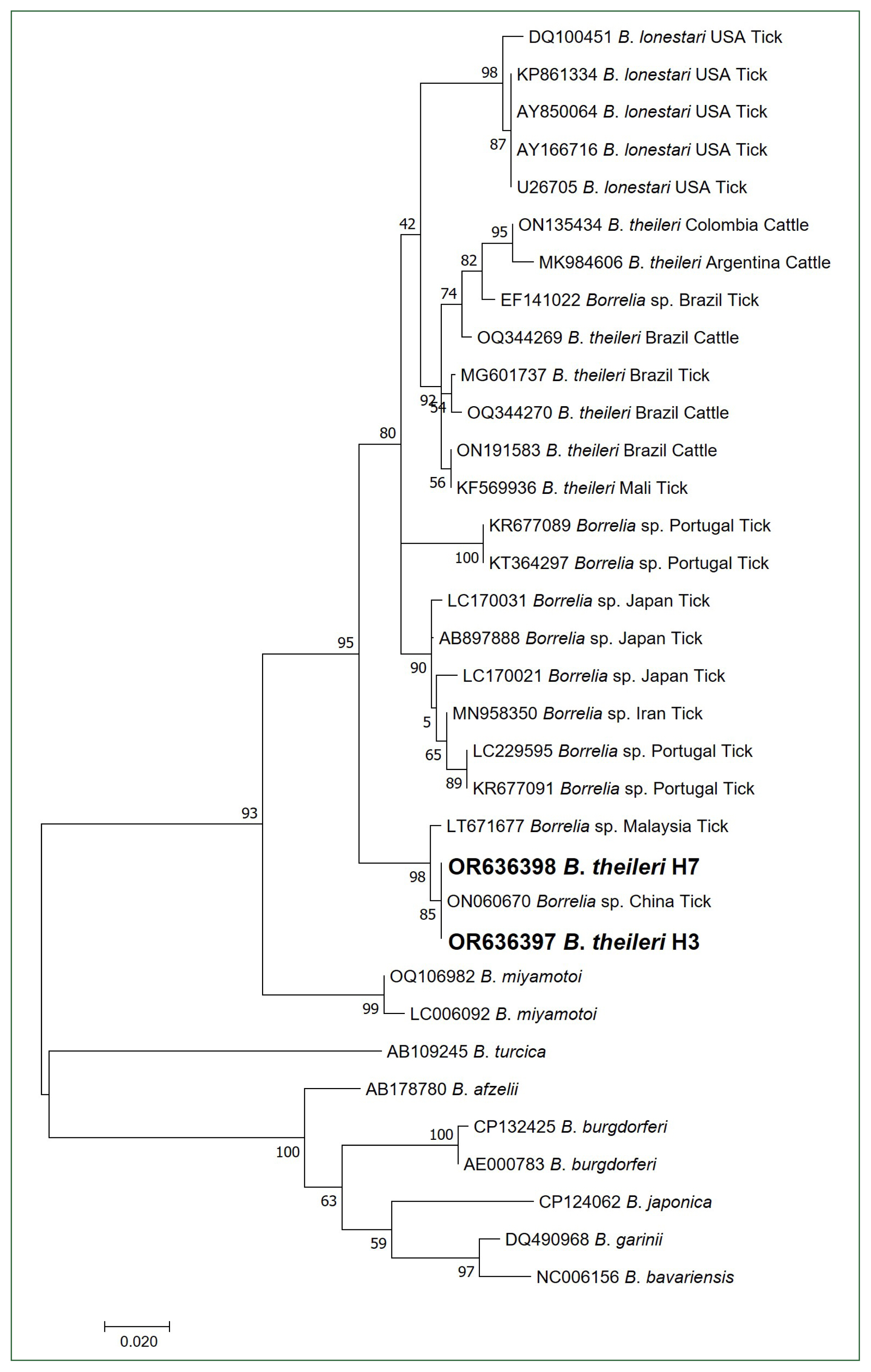Borrelia species, which are mainly transmitted by tick bites, are divided into 2 groups; one group causing Lyme disease and the other invoking relapsing fever [1]. Spirochetes in the Lyme disease group are associated with B. afzelii, B. garinii, and B. burgdorferi, which are primarily transmitted by hard ticks. Recently, the relapsing fever group has been further subdivided into soft-tick-borne (associated with B. coriaceae, B. duttonii, B. hermsii, B. microtii, and B. parkeri) and hard-tick-borne (associated with B. lonstari, B. miyamotoi, and B. theileri) subgroups based on their vectors [2]. B. theileri infects various animals, such as cattle, deer, horses, goats, sheep, and wild ruminants, in Africa, Australia, and South America [2–8]. Bovine borreliosis is caused by B. theileri that is transmitted via the bite of Rhipicephalus species and is associated with mild clinical symptoms, such as fever, lethargy, hemoglobinuria, anorexia, and anemia [2,4,9]. B. theileri DNA has been reported in raccoon dogs in southern part of Korean peninsula, while B. theileri-like Borrelia species have been reported in ticks obtained from goats in northern part of Korean peninsula [10,11]. However, no case of B. theileri infection has been reported in Korean cattle. This study aimed to investigate the presence of B. theileri in cows in Korea using nested PCR.
Blood samples were collected from the jugular veins of cattle in Korea into Vacutainer sodium heparin tubes (BD Biosciences, Franklin Lakes, NJ, USA) from October to December 2022. DNA extraction from the blood samples was performed using the FavorPrep Blood/Cultured Cell Genomic DNA Extraction Mini Kit (Favorgen Biotech, Ping Tung, Taiwan), following the manufacturer’s protocol. Conventional and nested PCRs were conducted using primers specific for 16S rRNA, outer surface protein A (ospA), outer surface protein C (ospC), and flagellin B (flaB) genes of Borrelia spp., as previously described [12–15]. The PCR reaction mixture consisted of 10–100 ng of genomic DNA for the first PCR, 1 μl of the first PCR product for the nested PCR, 10 pmoles of primers, 10×PCR buffer (TransGen Biotech, Beijing, China), 2.5 mm deoxyribonucleotide triphosphates (TransGen Biotech), and 1U of Taq polymerase (TransGen Biotech). Both the first and nested PCRs were performed in a total volume of 25 μl using a MiniAmp Thermal Cycler (Thermo Fisher Scientific, Waltham, MA, USA). The resulting PCR products were separated on a 1.5% agarose gel and were post-stained with ethidium bromide (Biosesang, Seongnam, Korea). Unfortunately, PCR products of ospA and ospC were not amplified, whereas only those of 16S rRNA and flaB were successfully amplified. The amplified PCR products were purified using the FavorPrep GEL/PCR Purification Kit (Favorgen Biotech) and cloned using the pLUG-Prime TA-cloning Vector Kit II (iNtRON Biotechnology, Seongnam, Korea). Ten colonies per sample were selected, and plasmid DNAs for sequencing were purified using the FavorPrep Plasmid DNA Extraction Mini Kit (Favorgen Biotech), according to the manufacturer’s instructions. Purified recombinant plasmid DNAs were sequenced using an automatic sequencer (3730xl Capillary DNA Analyzer; Applied Biosystems, Foster City, CA, USA). The obtained sequences were analyzed using Chromas software (Ver 2.66). To compare the sequences generated from this study with those in the GenBank database, the sequences were aligned using Clustal X (Ver 2.1) and analyzed using MEGA 7. Phylogenetic trees were constructed using the maximum likelihood method based on the Tamura-Nei model, and the dataset was resampled 1,000 times to generate bootstrap values.
In total, 101 blood samples were collected from grazing Hanwoo cattle, which is a breed of cattle indigenous to Korea, from 2 provinces (Chungnam, n=67; Gyeongnam, n=34). Two samples tested positive for B. theileri (1.98%). B. theileri 16S rRNA and flaB were detected using nested PCR. The amplicon sizes obtained were 507 and 323 bp, respectively. The obtained B. theileri 16S rRNA sequences, H3 (OR626045) and H7 (OR626046), were identical to each other and showed 100% homology with a B. theileri sequence (KY458576) obtained from a raccoon dog in Korea. Additionally, these B. theileri sequences exhibited 99.86% homology with a Borrelia sp. sequence (KC422269) isolated from ticks in North Korea, 99.58% homology with a B. theileri sequence (MN621894) isolated from sheep in Egypt, and 99.58% homology with a B. theileri sequence (U38375) isolated from ticks in Mexico. Based on phylogenetic analysis, the 16S rRNA sequences (H3 and H7) were unequivocally identified as belonging to the B. theileri group (Fig. 1). As the 16S rRNA gene is highly conserved, we conducted additional PCRs using primer sets that target the Borrelia flagellin gene. The obtained B. theileri flaB sequences, H3 (OR636397) and H7 (OR636398), were identical to each other and showed 100% homology with a Borrelia sp. sequence (ON060670) isolated from ticks in China, 99.38% homology with a Borrelia sp. sequence (LT671677) isolated from ticks in Malaysia, 95.67% homology with a B. theileri sequence (ON191583) isolated from cattle in Brazil, 95.36% homology with a Borrelia sp. sequence (AB897888) isolated from ticks in Japan, 95.36% homology with a B. theileri sequence (MG601737) isolated from ticks in Brazil, 95.05% homology with a B. lonstari sequence (AY850064) isolated from ticks in the USA, and 94.74% homology with a B. theileri sequence (ON135434) isolated from cattle in Colombia.
Unlike the 16S rRNA phylogenetic analysis, the obtained flaB sequences were not included in the B. theileri group and clustered with an unidentified Borrelia species group (Fig. 2). Several reasons could explain these observations. First, the number of registered flaB sequences for B. theileri in GenBank was notably low, suggesting the inadequate analysis of nucleotide variations among Borrelia species. Second, although speculating solely based on the current results is not completely accurate, potential evolutionary differences in flagellin genes may be observed in Borrelia species found in Asian regions compared to the known B. theileri species found in other regions. The primary vectors of B. theileri are Rhipicephalus species, which inhabit Africa, Australia, South America, and Southern Asia [2]. Moreover, Rhipicephalus sanguineus has been identified; however, it is a rare tick species in Korea [16]. In contrast, Haemaphysalis species are the predominant hard tick species in Korea [10,17]. Moreover, Hanwoo is a breed of cattle unique to Korea. These environmental differences between ticks and their hosts may affect the presence of B. theileri.
Currently, only 4 B. theileri sequences from Korea, including those presented in this study, are available in the GenBank database for phylogenetic analyses. Although we attempted to isolate this bacterium for precise species analysis, our efforts were unsuccessful. Nevertheless, this study is the first to use molecular techniques to confirm the presence of B. theileri in domestic livestock of Korea. However, further research is necessary to confirm the characteristics of B. theileri strains in Korea via B. theileri isolation and nucleotide sequence analyses. Additionally, future studies should investigate the presence of B. theileri in the predominant hard tick species (Haemaphysalis species) of Korea.








